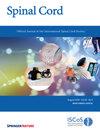量化成人脊髓损伤住院患者指南不一致的间歇导尿:一项回顾性队列研究。
IF 2.2
4区 医学
Q3 CLINICAL NEUROLOGY
引用次数: 0
摘要
研究设计:回顾性队列研究。目的:探讨脊髓损伤(SCI)患者住院期间不符合指南的清洁间歇导尿(CIC)的特征,探讨不符合指南的CIC的预测因素,并探讨其与尿路感染(UTI)的关系。环境:大型学术卫生系统内的急症护理医院。方法:使用电子健康记录(2021年1月9日- 2023年9月30日),我们确定了出院诊断为SCI和≥1个记录CIC膀胱输出的住院成年人。主要结局是不符合指南的CIC(膀胱输出容量> 500ml和/或CIC > 6h之间的时间)。采用广义线性模型和卡方检验评价与指南不一致CIC相关的患者因素和UTI风险。结果:该研究纳入了413例SCI患者,涵盖了519次住院期间的8,016次CIC测量。他们的平均(SD)年龄为55.2(20.6)岁,女性34.7%,黑人46.8%,医疗保险覆盖52.8%,79.4%患有胸腰椎水平的脊髓损伤。50.2%的CICs与指南不一致。男性和有管理式医疗保险的患者发生指南不一致CIC的几率显著更高(OR = 1.34, 95% CI, 1.03至1.73,OR = 2.05, 95% CI, 1.18至3.54)。在开始CIC前留置导尿管≥12天的患者发生指南不一致CIC的几率显著降低(OR = 0.65, 95% CI, 0.49 ~ 0.84)。与指南不一致CIC住院患者的UTI发生率为12.5%,而与指南一致CIC住院患者的UTI发生率为10.4% (P = 0.49)。结论:一半的CICs没有遵守指南,强调了质量改进倡议的必要性。进一步研究尿路感染和CIC护理模式之间的关系是必要的。本文章由计算机程序翻译,如有差异,请以英文原文为准。

Quantifying guideline-discordant intermittent catheterization in adults hospitalized with spinal cord injury: a retrospective cohort study
Retrospective cohort study. To characterize guideline-discordant clean intermittent catheterization (CIC) during hospitalizations of patients with spinal cord injury (SCI), explore predictors of guideline-discordant CIC, and examine its association with urinary tract infection (UTI). Acute care hospitals within a large academic health system. Using electronic health records (9/1/2021-9/30/2023), we identified adults hospitalized with a discharge diagnosis of SCI and ≥1 documented CIC bladder output. The primary outcome was guideline-discordant CIC (bladder output volume >500 mL and/or time between CIC > 6 h). Generalized linear model and Chi-square test were used to evaluate patient factors and UTI risk associated with guideline-discordant CIC. The study included 413 patients with SCI covering 8,016 CIC measurements during 519 hospitalizations. Their mean (SD) age was 55.2 (20.6) years, with 34.7% female and 46.8% Black. 52.8% were covered by Medicare. 79.4% had a thoracolumbar-level SCI. 50.2% of CICs were guideline-discordant. Males and those with managed care insurance had significantly higher odds of guideline-discordant CIC (OR = 1.34, 95% CI, 1.03 to 1.73 and OR = 2.05, 95% CI, 1.18 to 3.54, respectively). Patients with an indwelling catheter for ≥12 days before initiating CIC had significantly lower odds of guideline-discordant CIC (OR = 0.65, 95% CI, 0.49 to 0.84). The UTI incidence was 12.5% in hospitalizations with guideline-discordant CIC compared to 10.4% with guideline-concordant CIC (P = 0.49). Half of CICs did not adhere to guidelines, highlighting the need for quality improvement initiatives. Further research examining the association between UTI and CIC care patterns is warranted.
求助全文
通过发布文献求助,成功后即可免费获取论文全文。
去求助
来源期刊

Spinal cord
医学-临床神经学
CiteScore
4.50
自引率
9.10%
发文量
142
审稿时长
2 months
期刊介绍:
Spinal Cord is a specialised, international journal that has been publishing spinal cord related manuscripts since 1963. It appears monthly, online and in print, and accepts contributions on spinal cord anatomy, physiology, management of injury and disease, and the quality of life and life circumstances of people with a spinal cord injury. Spinal Cord is multi-disciplinary and publishes contributions across the entire spectrum of research ranging from basic science to applied clinical research. It focuses on high quality original research, systematic reviews and narrative reviews.
Spinal Cord''s sister journal Spinal Cord Series and Cases: Clinical Management in Spinal Cord Disorders publishes high quality case reports, small case series, pilot and retrospective studies perspectives, Pulse survey articles, Point-couterpoint articles, correspondences and book reviews. It specialises in material that addresses all aspects of life for persons with spinal cord injuries or disorders. For more information, please see the aims and scope of Spinal Cord Series and Cases.
 求助内容:
求助内容: 应助结果提醒方式:
应助结果提醒方式:


